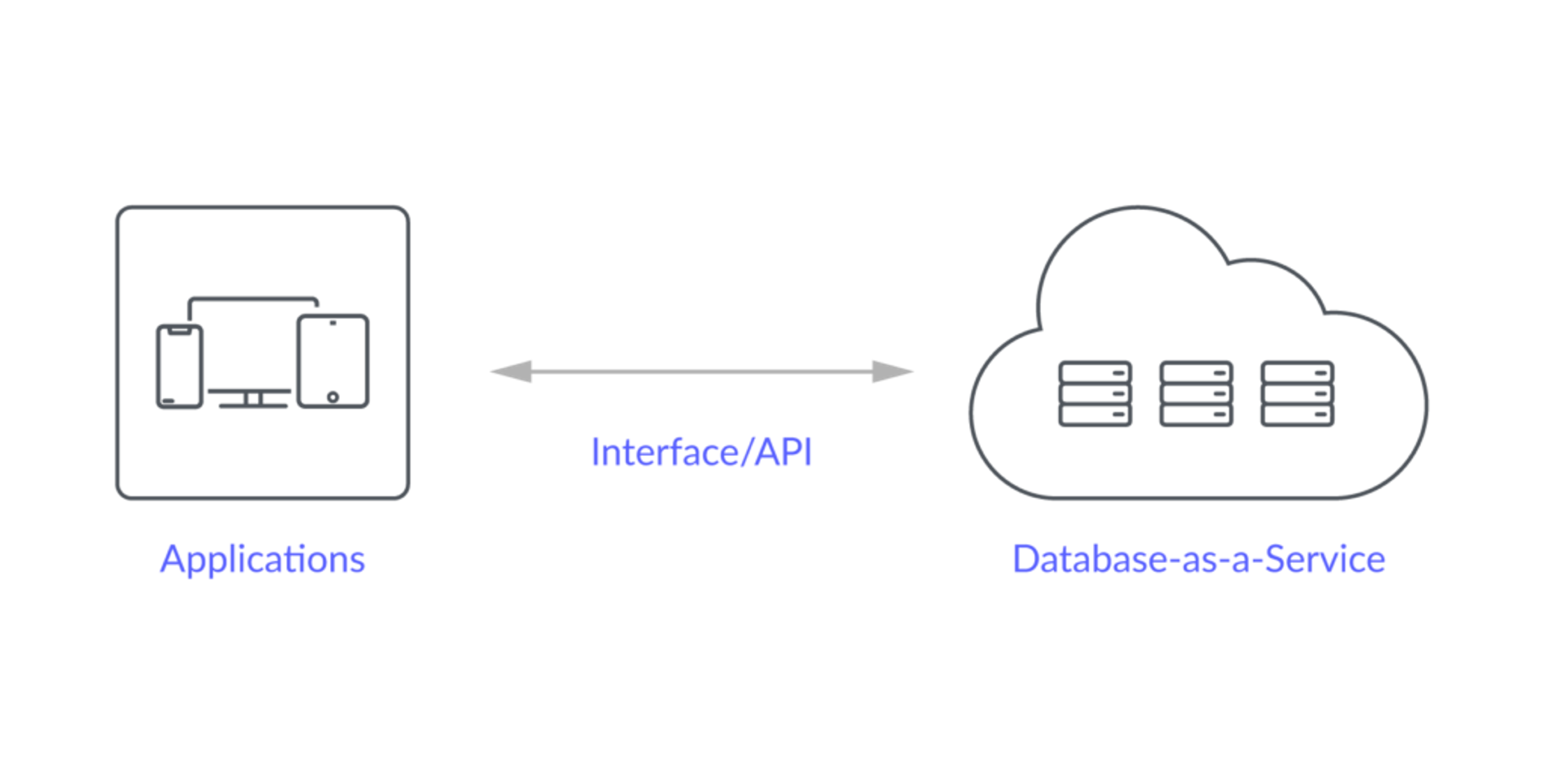Blog
What is Database-as-a-Service (DBaaS)?
What is Database as a Service (DBaaS)?
Database-as-a-Service (DBaaS) is a hosted or managed cloud service model that lets users and companies easily access database services without managing software or infrastructure as service providers handle the database management.
Database Types
Relational and non-relational databases (or NoSQL databases) constitute the two main database types. Redis, for instance, is a NoSQL database.
Relational Databases
Relational databases are a mainstay based on their long history, however a more traditional relational database like a SQL database does not allow users to work with data as close to the application as a NoSQL database.
Non-Relational Databases
NoSQL databases were initially developed as open source and were designed for large-scale data storage. In addition they allow for parallel, high-performance data processing.
Read more about the difference between a relational database and non-relational database and why your SQL server needs Redis.
How does Database as a Service work?
DBaaS providers host all your database infrastructure and data while enabling access through API endpoints. They follow best practices and operate all the databases, which means they take care of rapid provisioning, scalability, resiliency, failover, backup, and restoration.
In addition, DBaaS providers normally offer various features such as monitoring, alerts and notifications, round-the-clock support, and geo-replication for availability and backups. All maintenance and administrative tasks are handled by the service provider, freeing up users to benefit from using the database without the overhead of managing it.

What are the benefits of Database as a Service?
DBaaS provides a zero-management and cost-effective solution that gives developers and companies faster, scalable deployments while reducing IT costs. The major benefits of DBaaS include:
Business agility
Business agility refers to the distinct qualities (such as adaptability, flexibility, balance) that allow organizations to respond rapidly to changes without losing momentum or vision. Cloud DBaaS applications are agile in nature, so they adapt seamlessly to any upgrades according to business or technology advancements. DBaaS allows rapid provisioning of database resources to provide new computing resources and storage facilities in the minimum possible time. Together, this adds agility and flexibility to development teams, no matter their size or industry.
The result is that developers and DevOps teams don’t have to bother with complex and time-consuming database provisioning and management, which can take anywhere from several hours to days to complete. Instead, they can focus on delivering on the business’ goals.
Enterprise-level security
Security is one of the most critical challenges in the DBaaS domain. As more and more enterprises host their data in the cloud, it’s crucial for DBaaS providers to prevent unauthorized access to data resources, disallow misuse of data stored on third-party platforms, and ensure data confidentiality, integrity, and availability.
DBaaS providers typically offer enterprise-level security that supports encryption and multiple layers of security to protect data at rest, in transit, and during processing. It also improves your data center security by adding strategic layers of protection that keep your data and systems safe. DBaaS providers offer SLAs that guarantee integrated access management and control of regulatory compliance standards. They also offer end-to-end network security with micro-segmentation and virtual private networks.
On-demand scalability
The DBaaS model provides automated and dynamic scaling. DBaaS providers adapt to workload changes and are able to manage load variations by increasing resources during peak hours without any service disruption, or by allocating fewer resources during periods of non-peak usage to help reduce costs. Users can quickly add storage and computing capacity to meet high processing demands while also defining usage threshold policies for how the system should behave during demand fluctuations.
Modern applications are, by design, created in a more modular style. They can span multiple cloud providers or consume services from multiple clouds. Most of the time organizations focus their investment in a single vendor’s technology stack and hence rely on a single cloud provider. However, to increase agility and improve performance, your data layer has to span both
Redis Enterprise for example works on all the clouds to preserve operational flexibility. Read more about the growth of cloud computing and Kubernetes cloud adoption.
High availability
In today’s fast-paced digital world, maintaining 24×7 operational uptime is a must for any modern business. Outages are directly proportional to the loss of revenue. As digital transformation becomes more and more essential, it’s increasingly important that your application service should remain up 24/7 without any downtime. If there’s any kind of system failure, the system should be intelligent enough to recover from the loss in no time.
The DBaaS model provides maximum high availability and runs at peak performance. It provides zero or no-data loss tolerance and eliminates a single point of failure. In case of any kind of failure in a single database instance, the platform automatically reroutes traffic to a replica/standby instance and maintains uptime. The model is intelligent enough to accept the database connections and allow enterprise developers to perform database queries even in the case of a system failure. For developers building modern applications leveraging microservices with serverless and containers architecture, it is critical to consider the impact on application availability.
Is Database as a Service a good fit for your business?
Not all Database-as-a-Service providers are the same. They differ significantly across a wide range of characteristics and capabilities. It’s important to select the right DBaaS provider for your organization, one that meets the technical requirements of your application workloads.
Choosing the correct Database-as-a-Service (DBaaS) environment is critical to the success of any cloud-based database management system (DBMS). And this is an increasingly significant decision: The global cloud database and DBaaS market is expected to grow from an estimated $12 billion in 2020 to $24.8 billion in 2025, according to a recent Research and Markets report.
What’s driving that growth? The ever-increasing demand to process queries with minimum latency.
But when you look at the increasingly competitive DBaaS market, along with rapid advancement in cloud database architecture, technology, and features, it becomes clear that organizations must perform a detailed analysis of the competitive offerings and select the most appropriate DBaaS for their technology stack.
Managed Redis Database-as-a-Service
Redis Enterprise Cloud is a cost-effective, secure, and fully managed Database-as-a-Service solution. Whether your organization is fully hosted in the public cloud or in its own virtual private cloud (VPC), Redis Enterprise Cloud is perfectly suited to power the modern cloud native data layer.
Each of the major cloud providers today offers its own Redis managed database service, with those versions based on the open source Redis. Redis Enterprise Cloud is based on the proven Redis Enterprise technology, which serves the thousands of customers of our Redis Enterprise software products. Redis Enterprise can be deployed as a fully managed DBaaS over Amazon Web Services (AWS), Microsoft Azure, or Google Cloud; as a managed Kubernetes service over Amazon Elastic Kubernetes Service (EKS), Azure Kubernetes Service (AKS), and Google Kubernetes Engine (GKE); as software on bare-metal, virtual machines, Red Hat OpenShift Container Platform, or Pivotal Kubernetes Service (PKS); or in a hybrid model to preserve operational flexibility and avoid vendor lock-in. With Redis Enterprise Cloud, you can deploy quickly on any major public cloud and create Redis databases that are fully compatible with open source Redis clients.
Running Redis Enterprise as a managed service is the fastest way to deploy Redis Enterprise and get immediate time to value. Redis Enterprise is available via many cloud vendor marketplaces, including the AWS Marketplace, Microsoft Azure Marketplace, and Google Cloud Marketplace.
With modules, Redis Enterprise Cloud eliminates the need to operate and maintain specialty databases for every use case. Redis Enterprise incorporates ten data structures and several purpose-built modules to provide best-in-class performance across use cases. Additionally, RedisGears, a serverless in-database engine, supports transactions and trigger-based events across both Redis core and Redis modules with sub-millisecond latency.
Get started with Redis today
Speak to a Redis expert and learn more about enterprise-grade Redis today.
